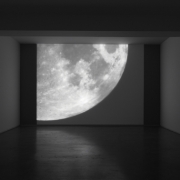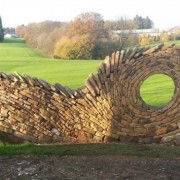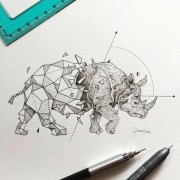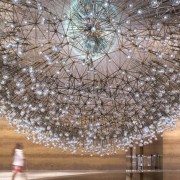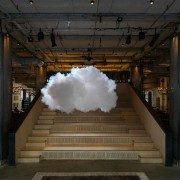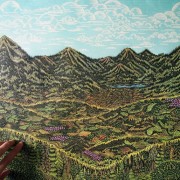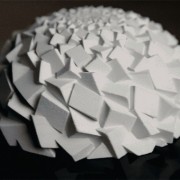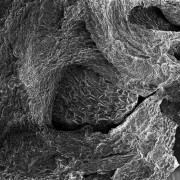
Johnny Clasper’s hypnotic free-form stonework is a swirling spectacle that garners its fair share of attention, and rightly so. The stonemason’s passion for his craft is apparent in every detailed design. From drystone sculptures to pebble mosaics and stone balancing acts, Clasper has a skill for transforming the commonplace material into works of art. The artist credits his upward trajectory on a passion for stone that carries him in many different directions. (source).
[easy-share buttons=”facebook,twitter,linkedin,mail” counters=0 native=”no” image=https://live-ehc-english-ucsb-edu-v01.pantheonsite.io/wp-content/uploads/2016/03/clasper1.jpg url=https://live-ehc-english-ucsb-edu-v01.pantheonsite.io/?p=12756 facebook_text=Share twitter_text=Tweet linkedin_text=Link text=”Swirling Stonework”]


In northwestern Poland, close to the village Nowe Czarnowo, lies the Krazywy Las-forest, which roughly translates to “The Crooked Forest.” No one knows exactly why the trees grew the way they did, and with that uncertainty all the more theories have arisen, varying from rational to spiritual ones, from tales about Nazis to tales about witches. The mist gives the already macabre forest an eerie, almost horrorlike quality, one that is only fed by its own myth. The trees were planted during the start of the World War II by the German army, but it’s not clear whether they are the ones responsible for the unusual growth of the trees. This month the German landscape photographer Kilian Schönberger drove to Poland to capture the mysterious forest in his aptly-named photo series The Crooked Forest. (source).
[easy-share buttons=”facebook,twitter,linkedin,mail” counters=0 native=”no” image=https://live-ehc-english-ucsb-edu-v01.pantheonsite.io/wp-content/uploads/2016/03/crookedforest1edit.jpg url=https://live-ehc-english-ucsb-edu-v01.pantheonsite.io/?p=12579 facebook_text=Share twitter_text=Tweet linkedin_text=Link text=”Geometric Beasts”]


Filipino ilustrator Kerby Rosanes’ Geometric Beasts series imagines Earth’s most majestic creatures breaking out from polygonal crystal chrysalises with a satisifying crackle. Whether you interpret it as a rise against humanity’s tendency to trap and impress members of the animal kingdom, or a fantastical scenario a lá the ressurrection of the stone creatures in C.S. Lewis’ The Lion, the Witch, and the Wardrobe, it’s a formula that works. Each animal, from a ram, to a lion, to a T-Rex, brings more joy from Geometric Beasts‘ simple conceit. (source).
[easy-share buttons=”facebook,twitter,linkedin,mail” counters=0 native=”no” image=https://live-ehc-english-ucsb-edu-v01.pantheonsite.io/wp-content/uploads/2016/03/georhino.jpg url=https://live-ehc-english-ucsb-edu-v01.pantheonsite.io/?p=12575 facebook_text=Share twitter_text=Tweet linkedin_text=Link text=”Geometric Beasts”]


The iconic Empire State Building in New York City was transformed into a moving tribute to endangered animals around the world. This spectacular light show, called Projecting Change: The Empire State Building, was organized by director Louie Psihoyos and producer Fisher Stevens of the Oscar-winning documentary The Cove, a film that explored dolphin hunting in Japan. Endangered creatures both large and small were depicted on the 33-story structure, including a black rhino, a humpback whale, and a bald eagle. The projections served as a companion to Psihoyos’s documentary, called Racing Extinction.
Producing the awe-inspiring sight was no easy feat — 40 stacked, 20,000-lumen projectors were placed on the roof a building on West 31st street. Together, they turned the Empire State Building into a shining beacon of hope for these voiceless animals, acting as reminder of how little time some of these species have left. (source).
[easy-share buttons=”facebook,twitter,linkedin,mail” counters=0 native=”no” image=https://live-ehc-english-ucsb-edu-v01.pantheonsite.io/wp-content/uploads/2016/02/projectingextention3edit.jpg url=https://live-ehc-english-ucsb-edu-v01.pantheonsite.io/?p=12424 facebook_text=Share twitter_text=Tweet linkedin_text=Link text=”Projecting Change”]


Artist Wolf Buttress has created a sculptural installation that looks like a giant dandelion wafting in the breeze. Titled Lucent, this larger-than-life orb is suspended above a darkened, reflecting pool that mirrors the brilliant illuminated tips, doubling its stunning presence. The installation’s name, derived from the Latin “to shine,” and its 3,115 hand-blown glass spheres represent stars on a map that are visible to the naked eye from the Northern hemisphere. To fully realize this sublime, suspended sculpture, Buttress affixed fiber optic cables to each orb, producing the piece’s diffused glow. Additionally, he ensured its spatial accuracy by working with astrophysicist Dr. Daniel Bayliss of Australian National University. Buttress also uses the reflective aspect of the piece as more than a visually appealing element, it is a conceptually integral part of Lucent. Its mirroring on the water suggests the Southern hemisphere, and implies a sense of infinity at the same time. (source).
[easy-share buttons=”facebook,twitter,linkedin,mail” counters=0 native=”no” image=https://live-ehc-english-ucsb-edu-v01.pantheonsite.io/wp-content/uploads/2016/02/WolfgangButtress2edit.jpg url=https://live-ehc-english-ucsb-edu-v01.pantheonsite.io/?p=12418 facebook_text=Share twitter_text=Tweet linkedin_text=Link text=”Lucent”]


They say you can’t control the weather—but for Berndnaut Smilde, that’s exactly his life’s work. The Dutch artist is known for his “Nimbus” series, in which he creates perfect, fluffy clouds in unique indoor spaces: churches, castles, dungeons, and most recently, in honor of Frieze New York, NeueHouse on 25th Street. The only lasting memory of his series is singular photograph—the perfect picture of the cloud in that space—which Smilde and his team work endlessly to capture.
He loved the duality of bringing something outdoor, indoor, as well as the duality of clouds themselves. “They can, for example, stand for the divine but also for something threatening or misfortunate,” he said. “Clouds are something really universal. Something that people give meaning to.” (source).
[easy-share buttons=”facebook,twitter,linkedin,mail” counters=0 native=”no” image=https://live-ehc-english-ucsb-edu-v01.pantheonsite.io/wp-content/uploads/2016/02/nimbus.jpg url=https://live-ehc-english-ucsb-edu-v01.pantheonsite.io/?p=12415 facebook_text=Share twitter_text=Tweet linkedin_text=Link text=”Nimbus”]

Husband and wife team Paul Roden and Valerie Lueth are the artistic minds behind Tugboat Printshop. Established in 2006, the two employ the traditional process of printmaking to create high quality and affordable contemporary pieces. Through their work, the talented pair strive to keep the art of printmaking alive, fostering public appreciation and interest in the traditional process. After three years of meticulous drawing, carving, and printing, their original colour woodblock print Outlook has finally been unveiled.
Outlook is a dizzyingly detailed 46″ x 30″ landscape carving depicting rolling hills, sweeping fields, pine-dotted mountain ranges, and lush forests. Through the use of traditional art production processes, Tugboat Printshop can reveal how mass communication once distributed a simple message through complex mechanisms. (source).
[easy-share buttons=”facebook,twitter,linkedin,mail” counters=0 native=”no” image=https://live-ehc-english-ucsb-edu-v01.pantheonsite.io/wp-content/uploads/2016/02/tugboatprintshop12edit.jpg url=https://live-ehc-english-ucsb-edu-v01.pantheonsite.io/?p=12315 facebook_text=Share twitter_text=Tweet linkedin_text=Link text=”Tugboat Printshop”]

Desginer John Edmark’s 3D-printed Fibonacci zoetrope sculptures come alive as they spin beneath a strobe. Every time they turn 137.5º–a number known as the golden angle– a synced flash of light creates the apparent motion of an infinitely spiraling structure.
“If change is the only constant in nature, it is written in the language of geometry,” Edmark writes in his artist’s statement. Inspired by the same mathematics found in nature, such as the shapes of pinecones and sunflowers, Edmark created these works. (source).
[easy-share buttons=”facebook,twitter,linkedin,mail” counters=0 native=”no” image=https://live-ehc-english-ucsb-edu-v01.pantheonsite.io/wp-content/uploads/2014/11/yusuke-asai-waf-1.jpg url=https://live-ehc-english-ucsb-edu-v01.pantheonsite.io/?p=12086 facebook_text=Share twitter_text=Tweet linkedin_text=Link text=”Edmark’s Zoetropes”]

On a quiet island in Norway, a cavernous structure protruding out of permafrost holds over 770,000 seeds of plants from all over the globe in case of a sudden “doomsday” scenario or plant-pocalypse. This is the Svalbard Global Seed Vault, the spark for artist Kaitlyn Schwalje’s macrophotography project, Seeds Under Microscope.
“I work on the premise that a single captivating image can be enough to make an otherwise inaccessible and dense topic exciting. It’s a form of packaging,” explains Schwalje, whose background is in physics and designs. “Behind the image of a seed is a rich and timeless story about agricultural futures and climate change; a story spanning continents and centuries. Any level of investigation uncovers new knowledge.” (source).
[easy-share buttons=”facebook,twitter,linkedin,mail” counters=0 native=”no” image=https://live-ehc-english-ucsb-edu-v01.pantheonsite.io/wp-content/uploads/2016/01/seed-1.jpg url=https://live-ehc-english-ucsb-edu-v01.pantheonsite.io/?p=12081 facebook_text=Share twitter_text=Tweet linkedin_text=Link text=”Seeds Under Microscope”]


